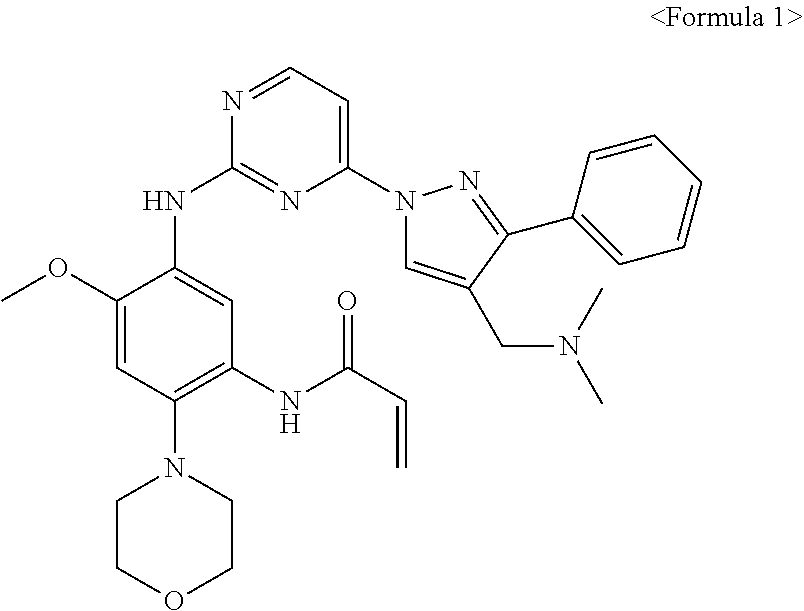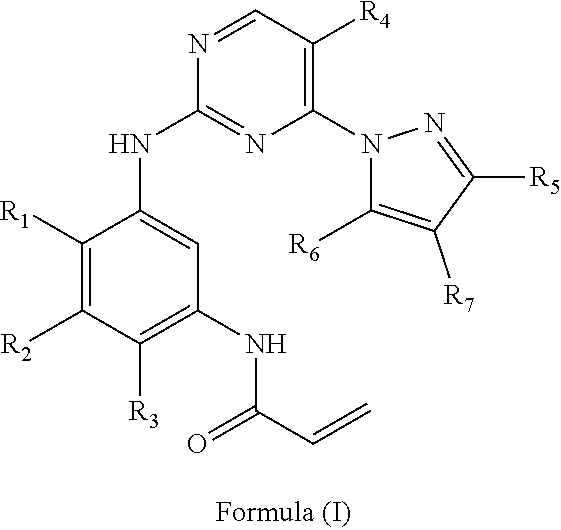Improved process for preparing aminopyrimidine derivatives
- Summary
- Abstract
- Description
- Claims
- Application Information
AI Technical Summary
Benefits of technology
Problems solved by technology
Method used
Image
Examples
example 1
on of 2-methoxy-4-morpholino-5-nitroaniline (Compound 13)
[0051]A mixture of 4-fluoro-2-methoxy-5-nitroaniline (60.0 g, 0.322 mol), acetonitrile (600.0 mL), diisopropylethylamine (83.3 g, 0.645 mol), and morpholine (84.2 g, 0.967 mol) was refluxed under stirring for 4 hours. To the reaction mixture, was purified water (1.8 L) added. The resulting solid was filtered and then dried in vacuo to obtain 78.0 g of the titled compound. (Yield: 95.5%)
[0052]1H-NMR (400 MHz, DMSO) δ 7.21 (s, 1H), 6.76 (s, 1H), 5.03 (s, 2H), 3.89 (s, 3H), 3.69 (t, 4H), 2.92 (t, 4H)
example 2
on of N-(2-methoxy-4-morpholino-5-nitrophenyl)formamide (Compound 11)
[0053]A mixture of anhydrous acetic acid (254.0 g, 2.487 mol) and formic acid (137.4 g, 2.984 mol) was stirred at 50° C. for 30 minutes. 2-Methoxy-4-morpholino-5-nitroaniline (210.0 g, 0.829 mol) and tetrahydrofuran (219.0 mL) were added to the reaction mixture, which was then stirred at 20-25° C. for 1 hour. To the reaction mixture, was methyl tert-butyl ether (2.1 L) added. The resulting solid was filtered and then dried in vacuo to obtain 211.0 g of the titled compound. (Yield: 90.5%)
[0054]1H-NMR (400 MHz, DMSO) δ 9.88 (s, 1H), 8.85 (s, 1H), 8.29 (d, 1H), 6.83 (s, 1H), 3.99 (s, 1H), 3.72-3.74 (t, 4H), 3.03-3.05 (t, 4H)
example 3
on of 4-chloro-2-(methylsulfonyl)pyrimidine (Compound 12)
[0055]A 35% hydrogen peroxide solution (90.7 g, 0.933 mol) and ammonium molybdate tetrahydrate (11.5 g, 0.01 mol) were added to a solution of 4-chloro-2-(methylthio)pyrimidine (50.0 g, 0.311 mol) in ethanol (250.0 mL). The reaction mixture was stirred for 2 hours and then extracted with dichloromethane (200.0 mL) and purified water (250.0 mL). The separated organic layer was washed with a 10% sodium sulfite solution and purified water and then concentrated under reduced pressure. The resulting residue was crystallized by adding isopropyl alcohol thereto. The resulting solid was filtered and then dried in vacuo to obtain 51.2 g of the titled compound. (Yield: 85.4%)
[0056]1H-NMR (400 MHz, DMSO) δ 9.05 (d, 1H), 8.06 (d, 1H), 3.42 (s, 3H)
PUM
 Login to View More
Login to View More Abstract
Description
Claims
Application Information
 Login to View More
Login to View More - R&D
- Intellectual Property
- Life Sciences
- Materials
- Tech Scout
- Unparalleled Data Quality
- Higher Quality Content
- 60% Fewer Hallucinations
Browse by: Latest US Patents, China's latest patents, Technical Efficacy Thesaurus, Application Domain, Technology Topic, Popular Technical Reports.
© 2025 PatSnap. All rights reserved.Legal|Privacy policy|Modern Slavery Act Transparency Statement|Sitemap|About US| Contact US: help@patsnap.com



